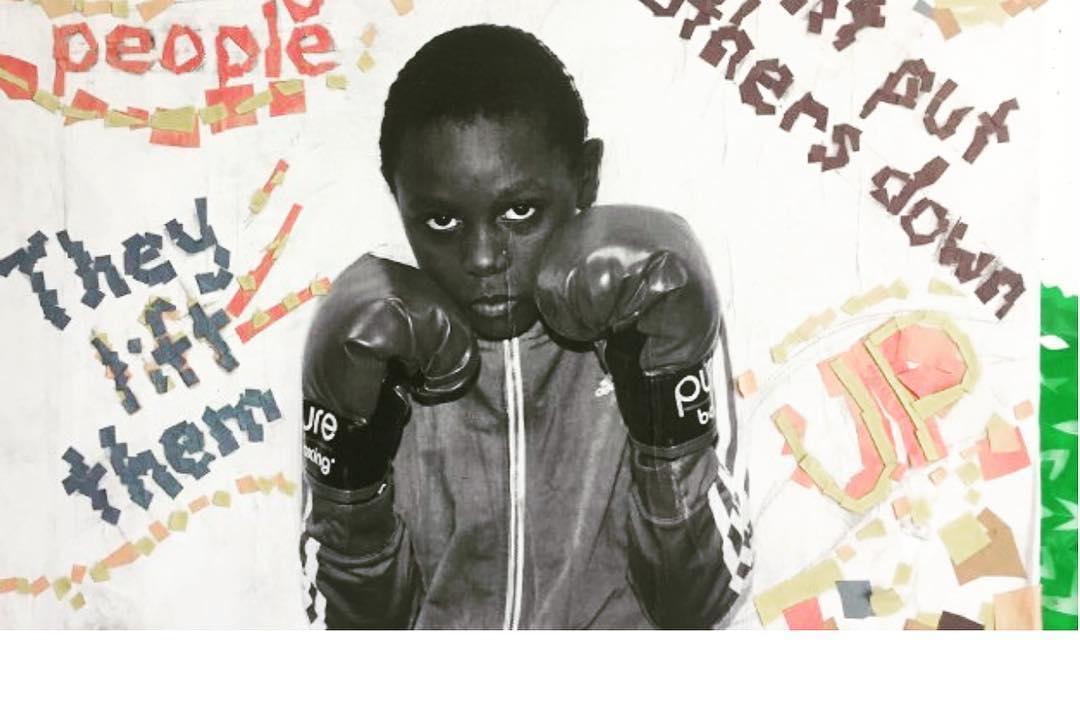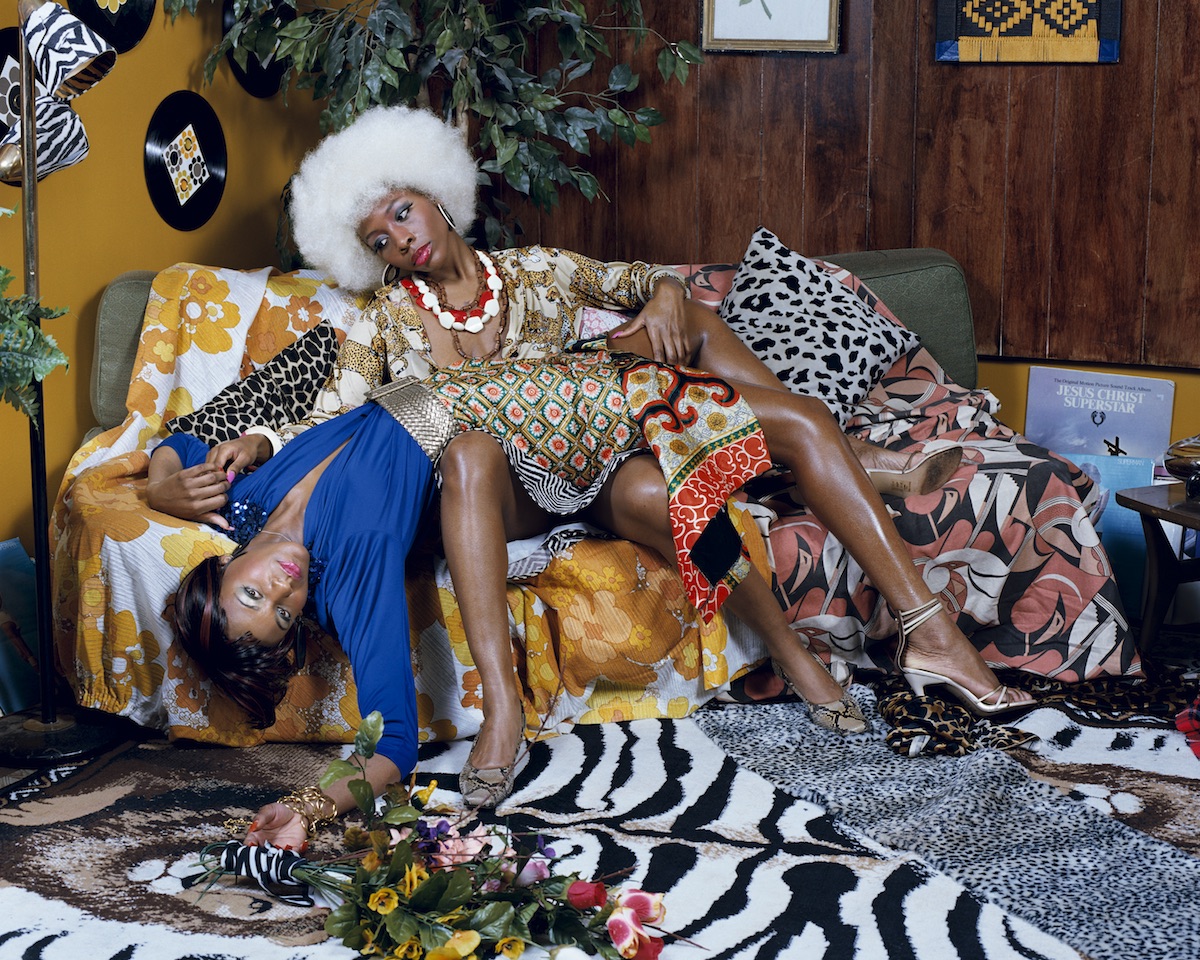Mickalene Thomas’ Muse and tete-a-tete at MICA Offers Powerful Visions of Black Femininity by Angela N. Carroll
It’s 1992. I’m at my auntie’s house digging through her vinyl collection. Sister Sledge, Chaka Khan, and Sade poster her walls. Anita Baker plays on the stereo. A lit incense shades the scent of whatever she’s smoking. She is the epitome of fly: red nails, gold bangles; a Zora Neale Hurston-reciting, no-fucks-given boss. Glitter and rhinestone cardigan, church hat tilted 45 degrees, rocking stilettos like sneakers, she slayed every day.
Looking at Thomas’ work reminds me of my auntie, her grace and poise. She and my mother were my first reflections of confident black feminized beauty. Thomas’ work recalls all of that fire, all of the memories and early images that informed my understanding of self.
 Mixed Media Collage by Mickalene Thomas
Mixed Media Collage by Mickalene Thomas
Influenced by the intimate interior spaces of black women’s homes, the fabulous clutch of black women’s fashion, Muse offers refreshing perspectives. Mickalene Thomas’ portraits are living muses: installations, large high-gloss photographs, pocket Polaroids, and collages inspired by women from her community of family members, lovers, friends, and artistic contemporaries.
The works selected for the Muse and tete-a-tete exhibition at the MICA Meyerhoff Gallery enunciate an intersectional black femininity; binary modes of identification like ratchet-or-regal, sensual-or-saintly, expand to encompass the meta-identities Thomas presents.
Each glamorous image invokes a celebratory aesthetic that embraces black bodies as beautiful. During an interview with ARTnet, Thomas shared that her intent is not specifically oriented around beautifying black women. “I think my work deals with a lot of ugliness,” she said. “When I think of beauty and how I present it, it’s not because I think life is, Oh, you’re beautiful or seductive. Beauty and its aspects of how young girls see themselves… Those are uncanny moments.”
 Deana Lawson, Hotel Oloffson Storage Room, Port-au-Prince, Haiti, 2015
Deana Lawson, Hotel Oloffson Storage Room, Port-au-Prince, Haiti, 2015
Much of Thomas’ queries are grounded in the performative and photographic works of a preceding generation of contemporary artists: Renee Cox, Carrie Mae Weems, Ellen Gallagher, LaToya Ruby Frazier, Deana Lawson, Lorna Simpson and others.
Many of these women’s photographs were included in the tete-a-tete exhibition that accompanied the traveling show. These women’s contributions, categorized as “identity politics” because the content centers non-white narratives, were radical in their methods of interrogation; bold rupturing of marginalized ascriptions, strategic use of body and home, (body as home, home as reflection of racialized body), to assert and critique identity structures.
Thomas’ slick photographic style investigates similar tropes, and visualizations of black domesticity in the seventies, eighties, and nineties. There is something familiar and familial about the way her subjects are framed. The textile patterns she employs and the postures her models assume are soulful and nostalgic, likened to the aesthetic of early black women’s publications: Essence, Ebony, Jet, Black Hair.
Thomas’ mother, who had a brief stint with modeling, sat for many of her throwback Foxy Brown-esque portraits. The misé en scene style Thomas constructs embody the erotic and the maternal: Mary Magdalene, Osun, Shakti, Ama, the waters. The images portray women boldly displaying all the feels, serving face to honor themselves and their reflections.
In “la lecon d’amour,” (image at top) two women are posed in an iconic posture; one lays gracefully collapsed across the lap of the other who stoically embraces her. Long brown legs shine against densely layered tapestries of varying design and pattern. The women in “La lecon d’amour” could be lovers, sisters, kindred. The portrait is reminiscent of classic Italian religious iconography, Michelangelo’s La Pieta (1499), or Giovanni Bellini’s Pieta Dona dalle Rose (1505). One wonders what cross the collapsed woman in Thomas’ image bears; is she slain in spirit, crisis, or la petite mort?

Thomas’ installations are assembled like altars, and like all things sacred, her curation of the objects she includes is specifically informed by her loves, guides and admirations: black women and, in particular, her mother. The environments she creates, down to the selection of books, knick-knacks, and plants, are embedded with the essence of those women. One cannot help but feel warmed and sincerely affirmed by each of those reflections.
In “Happy Birthday to a Beautiful Woman,” Thomas conducts an interview with her ailing mother about the joys and traumas of her life. The incredibly revealing 23-minute meditation is screened through an old-school television set installed within a prop living room set up in the back corner of the gallery.
Fully furnished and fitted to resemble a lived-in interior, viewers watch the television and feel very much like a guest in their home; sitting or standing just outside the perimeter, you listen to Ms. Bush share her story. The short is emotional and revealing, rendered as a means of resolve and reconciliation. In the same interview with ARtnet, Thomas shared, “My mother was and is still a huge part of my trajectory of my practice…. She’s been a part of my body of work since grad school.”
A confrontational gaze is a central component in this work. Around the opening of her first major solo exhibition, Origin of the Universe, Thomas shared in an interview at her studio, “The sitter has the authority of the gaze. Paintings are conceptually like mirrors, the gaze is a mirror.” Much of the intrigue surrounding Thomas’ creations is constructed around this confrontational intimacy created in her subject’s gaze; we enter the worlds she creates, we observe black women who stare back at us, nude, in lace lingerie, or silk and rhinestone glimmer.
We stand in observance of radiant reflections that encompass the whole of the spaces in which they are installed. Black women become visible in these spaces, their beauty esteemed and admired.
“To see yourself and for others to see you is a form of validation,” Thomas continued. “My work is about presenting beauty and the black body, reclaiming these spaces, once you put them out there you’ll see me. I exist.”

***********
Author Angela N. Carroll uses illustration, citizen journalism, documentary film, words, and experimental animation as primary mediums to contribute to and critique the archive. Music and meditation are her medicine. She is an artist-archivist; a purveyor and investigator of culture. Follow her on IG @angela_n_carroll or at angelancarroll.com.
Mickalene Thomas’ Muse and tete-a-tete is on display at the MICA Meyerhoff Gallery, January 27, 2017 – March 12th.
Bibliography:
Mickalene Thomas on Motherhood, the Mirror Stage, and Her Brooklyn Museum Show by Chloe Wyma, MODERN PAINTERS / Blouin Art Info, September 27, 2012
In the Artist’s Studio: An Interview with Mickalene Thomas and VIDEO: Mickalene Thomas discusses her work by Alexander Benrimon,






